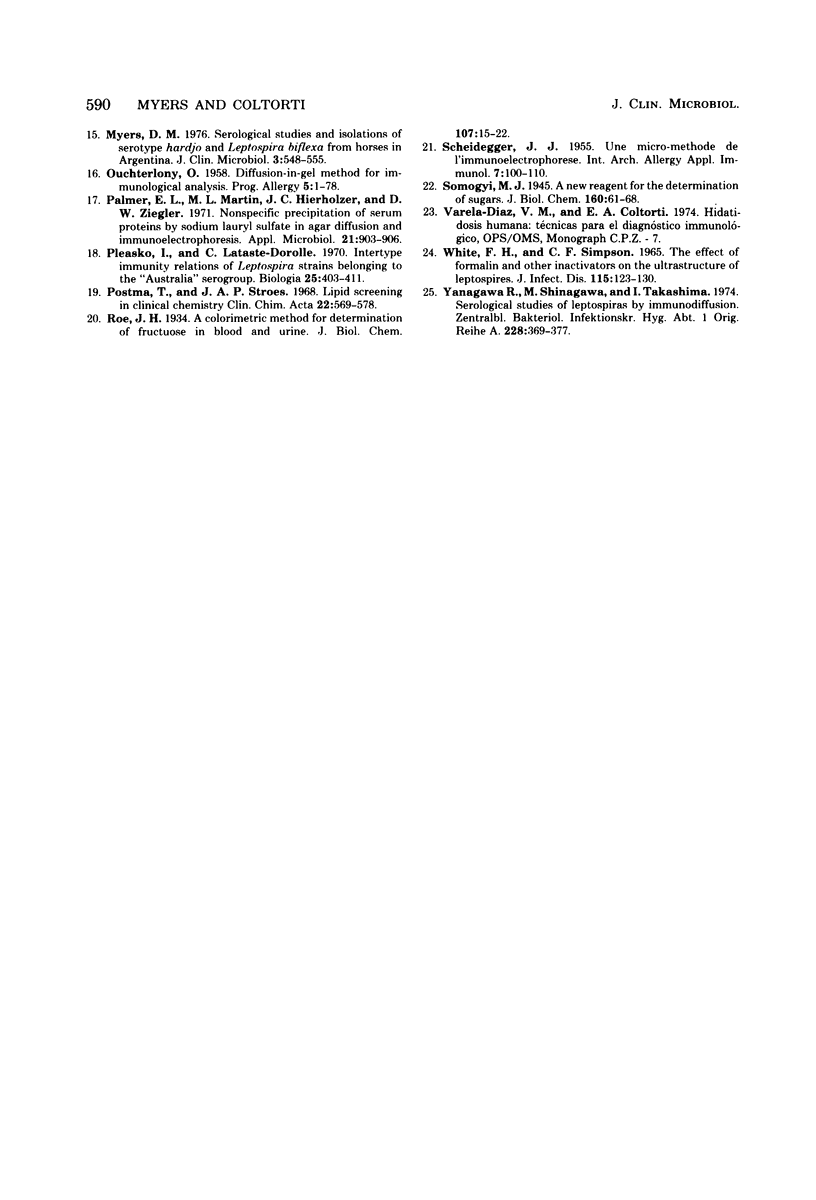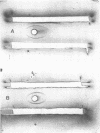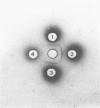Abstract
A saprophytic Leptospira biflexa strain of equine origin was found which cross-reacts with immune rabbit antisera to 14 pathogenic Leptospira interrogans serotypes. Sera from goats experimentally inoculated with the saprophyte showed multiple low-level cross-agglutination reactions against a battery of live L. interrogans serotypes. Sonically treated and saline-extracted suspensions of the L. biflexa strain and serotypes canicola, icterohaemorrhagiae, and pomona yielded a common precipitating protein antigen that was detected by immunodiffusion and immunoelectrophoresis with all of the antileptospiral sera examined. In cross-absorption and gel diffusion tests, the precipitinogen from each of the strains was shown to be identical. Formaldehyde treatments and heating at 100 degree C suggest that the cellular location of the common antigen is either somatic or subsurface, and Sephadex G-200 gel filtration enabled the isolation of the active fraction of the L. biflexa antigen. Monoprecipitin sera against the common antigen of L. biflexa were produced by immunizing rabbits with specific precipitates in agar. In gel diffusion and immunoelectrophoresis tests the antisera with each of the soluble antigens developed a single precipitin formation, and the antisera agglutinated formolized and heated whole-cell suspensions of serotypes canicola, icterohaemorrhagiae, and pomona at low dilutions. The soluble L. biflexa antigen was evaluated as an immunogen and in passive immunity tests for protection against death and kidney infection in hamsters. No cross-protection occurred when the hamsters were challenged with virulent leptospires. In contrast, the animals vaccinated or administered hamster immune serum before challenge died earlier than the control animals.
Full text
PDF










Images in this article
Selected References
These references are in PubMed. This may not be the complete list of references from this article.
- Anderson L. E., Jenkin H. M. Estimation of leptospiral viability with agar pour plates. Am J Vet Res. 1972 Dec;33(12):2587–2592. [PubMed] [Google Scholar]
- Auran N. E., Johnson R. C., Ritzi D. M. Isolation of the outer sheath of Leptospira and its immunogenic properties in hamsters. Infect Immun. 1972 Jun;5(6):968–975. doi: 10.1128/iai.5.6.968-975.1972. [DOI] [PMC free article] [PubMed] [Google Scholar]
- Bey R. F., Auran N. E., Johnson R. C. Immunogenicity of whole cell and outer envelope leptospiral vaccines in hamsters. Infect Immun. 1974 Nov;10(5):1051–1056. doi: 10.1128/iai.10.5.1051-1056.1974. [DOI] [PMC free article] [PubMed] [Google Scholar]
- Borg-Petersen C. A thermo-labile antigen in the Leptospira strain Ictero No. I. Trop Geogr Med. 1971 Sep;23(3):282–285. [PubMed] [Google Scholar]
- Cho C. T., Feng K. K. Non-immunological precipitation of serum by sodium dodecyl sulfate in agar diffusion. Appl Microbiol. 1974 Oct;28(4):557–560. doi: 10.1128/am.28.4.557-560.1974. [DOI] [PMC free article] [PubMed] [Google Scholar]
- Graves S., Faine S. subsurface location of non-agglutinating antigens of Leptospira interrogans (serotype Biflexa). Aust J Exp Biol Med Sci. 1974 Aug;52(4):631–637. doi: 10.1038/icb.1974.61. [DOI] [PubMed] [Google Scholar]
- Graves S., Faine S. trypsin extractable precipitating antigens of Leptospira interrogans (serotype Biflexa). Aust J Exp Biol Med Sci. 1974 Aug;52(4):615–629. doi: 10.1038/icb.1974.60. [DOI] [PubMed] [Google Scholar]
- Johnson R. C., Harris V. G. Differentiation of pathogenic and saprophytic letospires. I. Growth at low temperatures. J Bacteriol. 1967 Jul;94(1):27–31. doi: 10.1128/jb.94.1.27-31.1967. [DOI] [PMC free article] [PubMed] [Google Scholar]
- Johnson R. C., Walby J., Henry R. A., Auran N. E. Cultivation of parasitic leptospires: effect of pyruvate. Appl Microbiol. 1973 Jul;26(1):118–119. doi: 10.1128/am.26.1.118-119.1973. [DOI] [PMC free article] [PubMed] [Google Scholar]
- Kmety E., Galton M. M., Sulzer C. R. Further standardization of the agglutinin-absorption test in the serology of leptospires. Bull World Health Organ. 1970;42(5):733–738. [PMC free article] [PubMed] [Google Scholar]
- Myers D. M. Serological studies and isolations of serotype hardjo and Leptospira biflexa strains from horses of Argentina. J Clin Microbiol. 1976 Jun;3(6):548–555. doi: 10.1128/jcm.3.6.548-555.1976. [DOI] [PMC free article] [PubMed] [Google Scholar]
- OUCHTERLONY O. Diffusion-in-gel methods for immunological analysis. Prog Allergy. 1958;5:1–78. [PubMed] [Google Scholar]
- Palmer E. L., Martin M. L., Hierholzer J. C., Ziegler D. W. Nonspecific precipitation of serum proteins by sodium lauryl sulfate in agar diffusion and immunoelectrophoresis. Appl Microbiol. 1971 May;21(5):903–906. doi: 10.1128/am.21.5.903-906.1971. [DOI] [PMC free article] [PubMed] [Google Scholar]
- Plesko I., Lataste-Dorolle C. Intertype immunity relations of Leptospira strains belonging to the "Australis" serogroup. Biologia (Bratisl) 1970;25(6):403–412. [PubMed] [Google Scholar]
- Postma T., Stroes J. A. Lipid screening in clinical chemistry. Clin Chim Acta. 1968 Dec;22(4):569–578. doi: 10.1016/0009-8981(68)90105-8. [DOI] [PubMed] [Google Scholar]
- SCHEIDEGGER J. J. Une micro-méthode de l'immuno-electrophorèse. Int Arch Allergy Appl Immunol. 1955;7(2):103–110. [PubMed] [Google Scholar]
- WHITE F. H., SIMPSON C. F. THE EFFECT OF FORMALIN AND OTHER INACTIVATORS ON THE ULTRASTRUCTURE OF LEPTOSPIRES. J Infect Dis. 1965 Apr;115:123–130. doi: 10.1093/infdis/115.2.123. [DOI] [PubMed] [Google Scholar]
- Yanagawa R., Shinagawa M., Takashima I. Serological studies of Leptospiras by immunodiffusion. Zentralbl Bakteriol Orig A. 1974;228(3):369–377. [PubMed] [Google Scholar]






